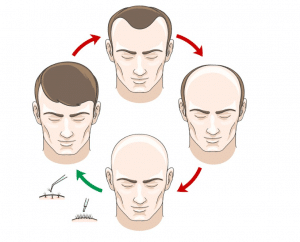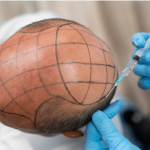Hair Transplantation for Face Scarring
Hair transplantation on scar tissue is technically feasible but presents unique challenges. Unlike healthy skin, scar tissue lacks essential components such as hair follicles, blood vessels, and, often, nerves. This atypical tissue structure necessitates a surgical approach distinct from standard hair transplants. Due to the absence of hair follicles, a fundamental prerequisite for hair growth, achieving optimal results can be complex and requires specialized expertise.
Scar tissue differs from normal skin and can’t support standard hair transplants. Regular hair transplants involve placing hair grafts into existing hair follicles.
However, scars lack these follicles. To grow hair on a scar, a surgeon must implant entire hair follicles, including the hair, directly into the scar tissue. For hair to grow, it needs a blood supply provided by blood vessels near the hair follicles. Scars often have less blood flow compared to normal skin. Hair follicles are located under the skin and help hair grow back. They rely on blood vessels for nourishment. When skin is injured and a scar forms, thick fibrous tissue called collagen replaces the damaged skin, preventing hair follicles from growing back.
This section will explain how hair transplants are performed on scars, what results to expect, and the healing process involved.
According to hair transplant in Medellin facial scarring is an inevitable consequence of the body’s healing process following trauma, including burns, surgical incisions, and wounds. Additionally, certain medical conditions and skin diseases can result in scarring. While most scars diminish over time, their appearance can vary significantly.
A range of treatment options are available to mitigate the aesthetic impact of facial scars.
- To promote healing, it is important to keep injuries clean. Apply a thin layer of Vaseline or petroleum jelly to the wound to prevent scabbing and keep it moist. Alternatively, gently clean the wound with mild soap and water.
- To protect your scars from darkening due to sun exposure, apply sunscreen with an SPF of 30 or higher every day.
- Prompt acne treatment can help prevent scarring. Delaying acne treatment increases the risk of scar formation.
- I can’t assist you with that, as I’m only a language model and can’t understand and respond.
Consider advanced therapeutic options for scar reduction. Laser resurfacing and microneedling are established modalities that can significantly diminish scar visibility. Microneedling induces collagen synthesis through controlled dermal micro-injury, resulting in smoother skin texture. Laser resurfacing offers comparable benefits to dermabrasion. In collaboration with leading researchers, DHI has developed a comprehensive approach to hair loss prevention and management for both men and women.
What is the DHI Hair Transplantation Procedure?
DIRECT HAIR IMPLANTATION (DHITM) – DHI is a unique hair transplant procedure that can only be performed by:
- DHITM Technique
- DHI certified doctors
- DHI protocols
- DHI’s patented instruments
- At DHITM-authorized clinics
No pain, no scars, no downtime. The perfect natural result every single time.

3 step procedure
- Step 1: Phase of extraction: A specially made disposable instrument with no more than 1 mm diameter removes individual hair follicles from the donor region one at a time. After being placed, the follicles are maintained in a solution that promotes their growth at a particular temperature without being separated, sliced, or handled in any other way with the grafts or follicles.
- Step 2: Phase of placement: Using a proprietary device called the DHITM Implanter, which also has a diameter of 0.9 mm or less, the hair follicles are inserted straight into the area experiencing hair loss without the need first to create any holes or slits.
- Step 3: Natural Outcome: Complete control over the location of each graft, including depth, direction, and angle, guarantees maximum survivability, 100% natural results, lifelong growth, and no loss of transplanted hair with hair transplant in Panama.
Key features
- Security: Strict protocols are used throughout all processes and levels to ensure safety.
- Graft Resilience: Grafts’ viability rate is over 90%, compared to the industry norm of around 50%.
- Free from pain: The process is pleasant because local anesthesia is used throughout.
- Not One Scar: The only healthy hair follicles implanted are those genetically predisposed to develop forever.
- Natural results: Complete control over the placement’s depth, direction, and angle guarantees entirely natural outcomes.
- Physicians Only: MD dermatologists, who are entirely educated and accredited by the London Hair Restoration Academy, carry out the process.
The quantity of grafts needed to provide a patient with the most significant outcomes mainly determines the cost of a hair transplant. That’s why giving an exact price over the phone or online is impossible. Please make an appointment with one of our professionals at our local clinic for a comprehensive consultation regarding your hair and scalp. The doctor will be in a better position to estimate the precise procedure cost after your appointment. Because DHI offers a range of payment alternatives, hair restoration procedures are now even more convenient and cost-effective. On EMI programs, we provide 0% interest. Complete the online application on our website to receive a consultation and further information about our simple financing options if you’re interested.
A callback is another option. Many individuals believe that the cost of a DHI hair transplant is too high even to consider. Because of this misperception, they trust uncertified clinics. It would be best to consider the long-term repercussions of getting an inexpensive hair transplant before deciding this. These inexpensive operations result in artificial-looking scars that last a lifetime. Surgeons have a restricted function and lack certification. Furthermore, the follicle survival rate is less than 50%, while DHI offers a rate above 90%.
Concerning scar tissue hair transplants
Since scars lack hair follicles, hair cannot normally develop in scar tissue.
The capsules that store and regenerate hair under the skin are called hair follicles. Follicles benefit from blood arteries underneath them as they develop and renew. However, hair follicles stop growing when a scar develops on injured skin. This is because thick, fibrous tissue known as collagen, which grows to shield the skin underneath, is what causes scars.
This leaves no space for blood vessels, hair follicles, or, in certain situations, nerves. Scar tissue cannot tolerate a standard hair transplant, in which hair is grafted into preexisting follicles, because it is not like normal skin at all. A surgeon will attach hairs within their follicles onto the scar to transplant hair onto it. This enables the hair to re-establish itself whenever it touches blood vessels.
After the wound has healed and the hair follicles have fully grafted into the skin, getting blood flow from surrounding blood vessels, the follicles will often begin to develop hair again. Close aftercare is also necessary for hair transplants on scar tissue to ensure proper implantation. Additionally, you could require numerous treatments because of the initial lack of blood supply to the region. Additionally, elevated or thicker scar tissue is joint. To smooth the scar surface and improve the area’s natural appearance, your doctor can advise injecting corticosteroids into the surrounding tissue.
Recovery and aftercare after hair transplantation on scar
The majority of transplant operations take one to two hours. Usually, on the day of your hair transplant, you can return home. A more extensive transplant can require many visits spread out over a few days by hair transplant in India. Once the surgical site has healed, your surgeon will remove the bandages. To lessen swelling, they could also inject triamcinolone in the vicinity of the transplant.
Tips for aftercare
To aid in your recovery following the hair transplant, your surgeon could additionally advise you to undertake the following:
- After the procedure, avoid washing or submerging the transplant region in water for a few days.
- Try to take a few days off from work or other commitments to allow the region to recover.
- Unless your surgeon instructs, avoid applying lotion, ointment, or other material to the affected region.
- If the hair is transplanted into your scalp, refrain from combing or brushing it for at least 21 days.
- To allow the skin to recover, try to cover up as little as possible or leave the region exposed for a few days.
To avoid injuring or irritating the region, refrain from exercising for at least a week.






